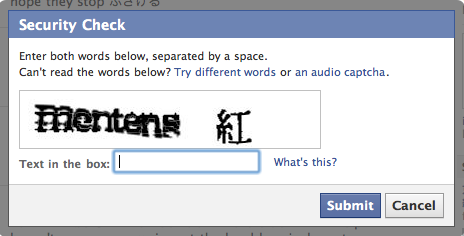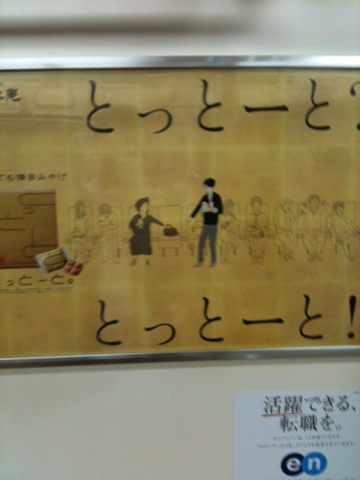- Buying a (simple) wristwatch is surprisingly difficult in the year 2014. Quite like pocket calculators and rotary phones, wristwatches have become the province of obsolete Forbes-reading execs… and people with a test to take. If you are between 25 and 60 and still own a wristwatch, you have a serious hoarding problem. Amazingly, even 100en stores do not sell these any more.
- The wristwatch is not really optional for the JLPT. Since I knew I would be short on time anyway, I figured I could wing it without one, and just go through as many questions as fast as I could. As it turns out, not only aren’t there any clock in the exam room, but the proctors make a point not to give any 5-minute warning before the time runs out (it’s in the test instructions). The first you hear of their voice, is to tell you to drop your pencil right this second (under penalty of elimination). This is how one ends up with over a dozen blank answers in their final sheet (where filling at random would have guaranteed at least a couple points).
- One can always make oneself feel better by telling oneself that they are not there to get the JLPT through cheap tricks and strategising. I’m still getting a wristwatch for next time.
Category: 日本語
Dave’s Birthday Party in Golden Gai
Next version makes you solve a differential equation
Making your iPhone SPEAK Japanese…
A very nifty trick I discovered while working on making KanjiBox accessible to blind users.
I previously mused that an iPhone/iPod made a much better and more cost-efficient language-studying tool than any dedicated electronic gizmo out there. This is now a thousand times truer…
One of the coolest features brought by version 4 of iOS (the software that runs on all iPhone/iPad/iPod Touch) is also one of the least known and used: VoiceOver is a built-in screen-reader geared at making Apple devices accessible to blind and visually impaired users. If you are such a user, you know about it already and will learn nothing here. For everyone else, this feature still has much to offer!
VoiceOver supports a dizzying collection of languages: from English to Japanese, Mandarin and Cantonese, most European languages, hell, even regional accents (English comes in US-, Brit- and Aussie-accented variants… Canadian-French as well). While the quality for English is about what you would expect from late-90s speech synthesis, the quality of some other languages is vastly superior. This is particularly true of the Japanese and French voices. To my very limited ear, Mandarin and Mexican-Spannish also sound quite close to human quality (Spain-Spanish, on the other hand, is pretty robotic).
As it turns out, your iPhone (/iPad/iPod Touch) comes with a native pronunciation teacher, out of the box. For hard-to-read languages like Japanese or Chinese, it can be a life-saver: helping you decipher SMS, emails or web pages, instead of relying on clunky, time-consuming, copy-pasting to a dictionary app.
Below are detailed instructions on how to enable VoiceOver and use it to read any text in any language on your iPhone (setup should be near-identical for iPads and iPod Touchs):
Fear peoples the darkness with monsters
Rarely used words and neologisms abound in recent Japanese news…
More than the news-fabricated fly-jin “trend”, my favourite Japanese phrase these days is 疑心暗鬼:
An idiom whose components literally translate to “fear – darkness – demons”, beautifully rendered by the Green Goddess into: “Fear peoples the darkness with monsters”…
In everyday conversation, it can be used as a synonym for “paranoia”.
Un momento… Estoy hablando japonés!
(context here, if you have never seen the original movie)
Yesterday, a friend emailed me about a New Year Party thrown by some friends of hers. I hastily misread the description of said friends from 狂言 (きょうげん: stage actors) to 狂信 (きょうしん: religious fanatics) and was, understandably, slightly less excited by the prospect than I should have been.
I could of course play that silly anecdote as yet another illustration of my terminally inept Japanese skills. But in the end, even though I had to quickly look up 狂信, the fact I instinctively knew its reading and felt confident enough to make that mistake makes me feel surprisingly happy about the shape of my Japanese.
About 8 years ago, I decided to learn Japanese. Or more exactly: I hurriedly learnt a dozen Japanese words, fragments of grammar and notions of kana reading, landed in Japan, promptly got drowned in an ocean of linguistic helplessness, then decided that, one day, a visit to my local bank would not turn into low-grade stand-up comedy (at my expense).
When you think about it, 8 years is a pathetically long time for someone who still can’t read a newspaper without a dictionary (and lots of spare time)… Slightly less shameful, I guess, if you account for my constantly travelling back and forth over that period. Also: while I have come to appreciate countless aspects of Japanese culture and developed a perverted obsession with matters of kanji writing, I did not grow up obsessed with Japan. I never had a strong personal interest in learning this particular language (or living here, for that matter) and might just as happily have taken on Russian (maybe will, who knows). It slowly grew from a mix of absolute happenstance, necessity, frustration and stubbornness when confronted with near-impossible challenges (yes: I am the kind of asshole who will devote a sizable share of a decade to learning a language, just because: fuck-it-I-can-do-it).
Tottohto!
Waste of memory storage
Try as I may, I keep forgetting the kanji for 遺伝子 (いでんし: “gene, genetics”)…
On the other hand I have absolutely no trouble remembering words like 居合い (いあい: “act of drawing one’s katana, killing with a single stroke, shaking out the blood and sheathing the katana back, as one single movement” — yes, it means all that; no, I am not kidding) after seeing them used exactly once.
Which would be great if, you know, there was more assisting with friends’ seppuku and less messing around with genes, in my life right now.
3 Apps to Turn your iPod into a Japanese Study Tool…
Strolling through Bic Camera the other day, I stopped in the handheld electronic Japanese dictionaries aisle and had a quick look at prices for a laugh.
Seriously, who still buys these things?
My guess is: people who also just purchased a brand new Sony Minidisc player1“fit up to twenty tracks in your pocket!” and/or will only use devices that bears the same comforting look as the pocket calculator they had back in High School.
I don’t see why else anybody would willingly spend up to twice the price of an iPod Touch on a tool that will, at best, do roughly what any iPod/iPhone does… minus the thousands of non-Japanese-related features.
Trust me, I am very receptive to the argument of the simple tool that does one thing and does it well, without the clutter and confusion of a myriad peripheral features… But if that’s what it takes, buy an iPod Touch, forget it can be a music player, a web browser or a gaming platform and use it solely as a Japanese study tool: you will still be getting a better deal than with one of these ridiculously overpriced/underfeatured denshi jisho.
In case you are considering such a purchase, or if you already own an iPhone/iPod Touch and wondered what apps you should get in order to turn it into the ultimate Japanese studying tool, here are my three picks:
Think you know Japanese music?
End-of-year Japanese Music Quiz, over at KanjiBox’s dev blog: 10 tracks, 10 artists, many genres…
Guess them all and win a bunch of iTunes coupons for free installs of KanjiBox for iPhone (along with my undying respect for your extensive musical culture).








